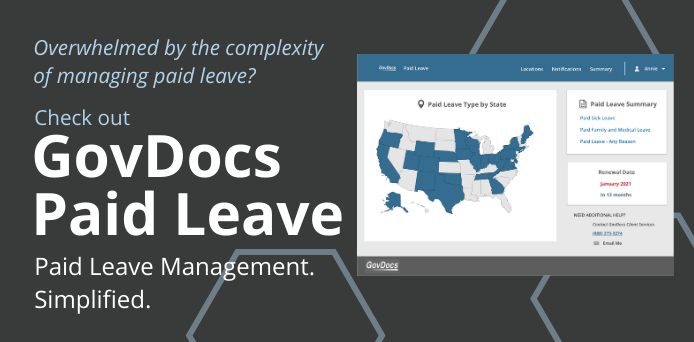EMPLOYMENT LAW NEWS
Coronavirus: Federal Government Enacts Emergency Paid Sick Leave, Family and Medical Leave
By Kris Janisch
Published March 19, 2020

The bill, which marks the first time the federal government has ever provided paid leave, goes into effect April 2 and expires Dec. 31.
Looking to combat the impacts of the coronavirus pandemic, President Trump on March 18 signed a bill that gives emergency paid sick leave and paid family and medical leave to American employees.
It’s the first time in the history of the U.S. workers will receive paid leave from the federal government, though the legislation is specifically tailored to those dealing the impacts of COVID-19, the disease caused by the coronavirus.
The bill goes into effect in two weeks (April 1) and expires Dec. 31.
However, not all employees will be covered by the paid leave bill, called the Families First Coronavirus Response Act. Most notably, businesses with 500 or more workers are excluded.
Meanwhile, although paid family and medical leave is unpaid for the first 10 days, the paid sick leave would cover that timeframe.
Below, we’ll delve into each facet of the paid leave legislation.
Emergency Paid Sick Leave
The bill’s emergency paid sick leave act component applies to all workers regardless of their length of employment. It applies to the government employers and private employers with less than 500 employees.
Full-time employees are eligible for 80 hours of paid sick leave, which can be taken immediately. Part-time employees are eligible for a pro-rata portion of this.
The amount of paid sick leave an employee can take is in addition to any paid time off policy an employer currently maintains.
Eligible reasons for using federal emergency paid sick leave:
- For employee to comply with a federal, state, or local order quarantine or self-isolation due to COVID-19
- For employee to comply with an order by a healthcare provider to self-quarantine due to concerns related to COVID-19
- Employee is experiencing symptoms of COVID-19 and seeking medical diagnosis
- To care for a family member subject to a federal, state or local order to quarantine or self-isolate or due to COVID-19 or an order by a healthcare provider to self-quarantine due to COVID-19 related concerns
- To care for employee’s son or daughter whose school is closed, or childcare provider is unavailable due to COVID-19 precautions
Employees must be paid their regular rate of pay for absences due to their own coronavirus-related absences. If their absence is to care for a family member or child, the employee is eligible for two-thirds of their regular rate of pay.
Emergency Paid Family and Medical Leave
Under the paid family and medical leave portion of the bill, employees who have been employed for at least 30 days are eligible for paid leave.
It’s worth noting that they would not have to meet the standard requirements under the federal Family and Medical leave Act (FMLA) to be eligible for coronavirus related paid family leave. Those include:
- Having worked 1,250 hours
- Being employed for one year
- One of 50 employees working in a 75-mile radius
Under the new legislation, eligible employees could take up to 12 weeks of leave. The first 10 days would be unpaid, but employees could apply the 10 days of paid federal sick days to the unpaid family leave days. The remaining leave would be paid at two-thirds of the employee’s regular rate of pay.
The eligible reasons for emergency paid family and medical leave are also related specifically to COVID-19. The FMLA protections for coronavirus-related leave are:
- FMLA will only be available to an employee to care for a minor child because of a school closure or childcare-provider loss
- Inability to work during a childcare-related leave to include an inability to telework
Employees must be paid their regular rate of pay, capped at $511 per day and $5,110 in the aggregate, for absences due to their own coronavirus-related absences. If their absence is to care for a family member or child, the employee is eligible for two-thirds of their regular rate of pay, capped at $200 per day and $2,000 in the aggregate.
Employees taking leave must be reinstated to their regular position as required under federal FMLA.
Conclusion
This unprecedented step by the federal government may portend more paid leave and paid family and medical leave legislation in the future.
The impacts of COVID-19 are impacting nearly every facet of life, and the lasting effects will likely be felt long after the pandemic has passed.
New name. Same great content. To better reflect the nature of the GovDocs blog, and the company’s mission, we have updated the name. Welcome to Employment Law News!
This Employment Law News Blog is intended for market awareness only, it is not to be used for legal advice or counsel.
Keep Informed
with GovDocs Labor Law News
What is GovDocs?
GovDocs, Inc., is a leading provider of employment law management solutions for large, multilocation employers in the U.S. and Canada. With the GovDocs cloud-based platform, our clients easily manage labor law posting programs and minimum wage rates down to the individual location and across the enterprise. All GovDocs’ products are powered by continuous research and innovation to help clients be compliant. The company is headquartered in St. Paul, Minn.
Have fewer than 30 locations?
The GovDocs Poster Store simplifies posting compliance for employers with less than 30 locations across all industries, offering a variety of posting products to meet your labor law compliance needs.



